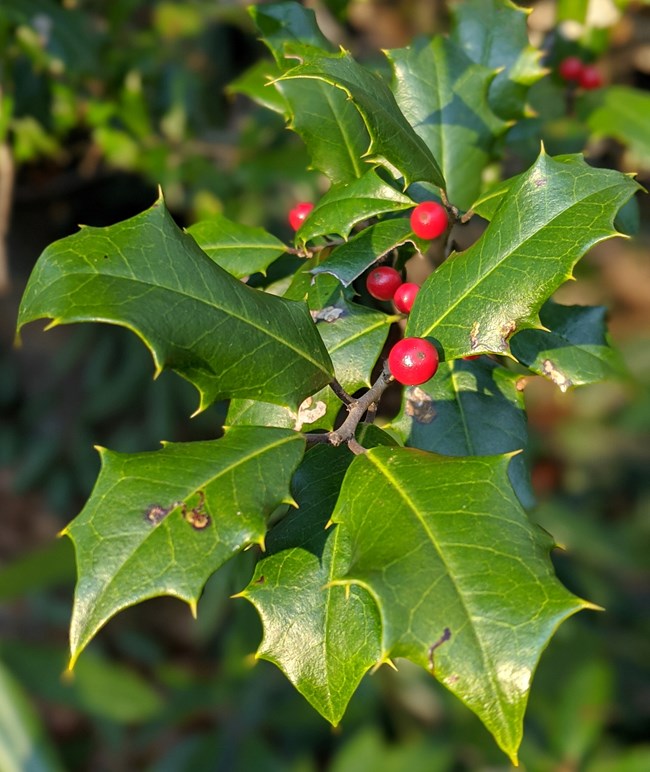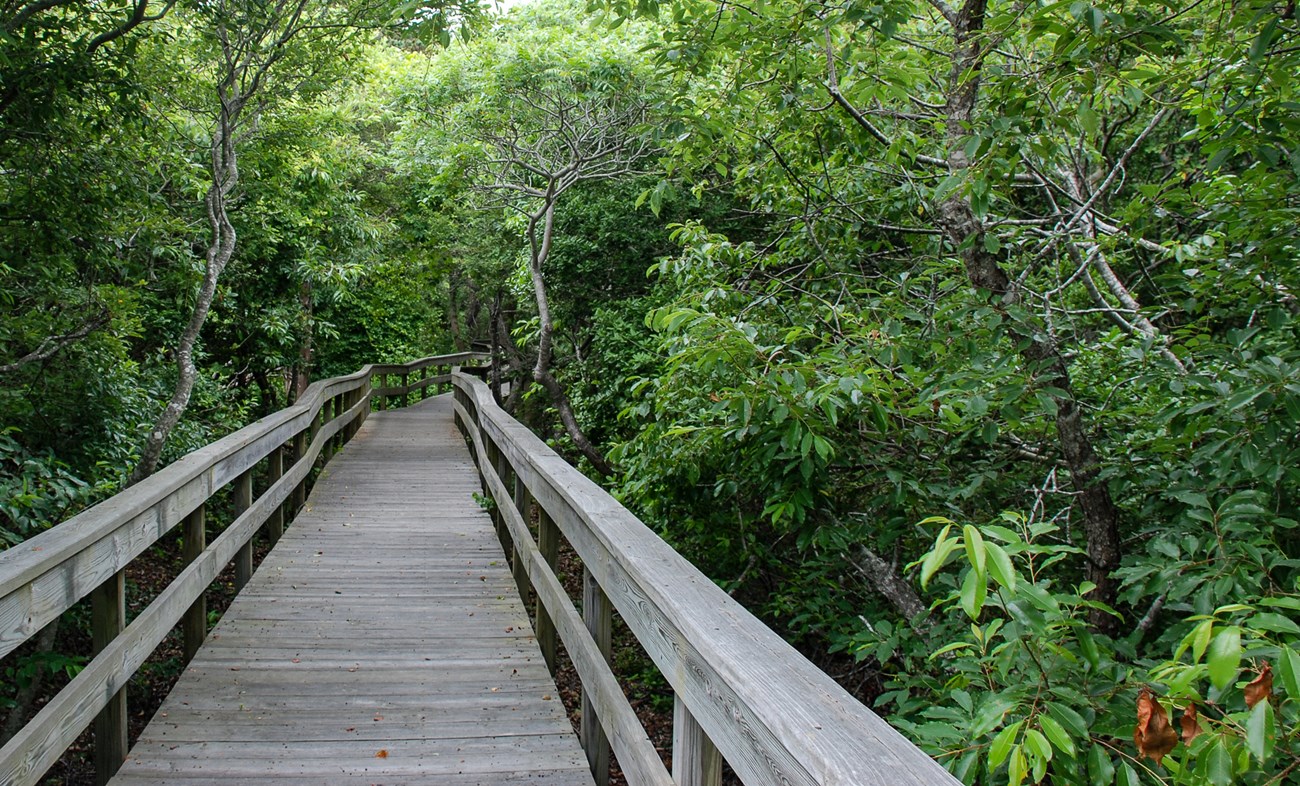Last updated: March 12, 2020
Article
This Park’s Personality: Jordan Raphael and the quest to preserve the Sunken Forest

Lynch/NPS
Few people have studied the Sunken Forest as closely as Jordan Raphael. For over a decade, his quest has been to discover what is happening to all of the ancient hollies here.
First established as a preserve in 1960, Sunken Forest, which is part of Fire Island National Seashore (FIIS), was once about one-and-a-half times the size of Ellis Island. Lately, Jordan says, it’s shrinking. A National Park Service Ranger and park biologist at FIIS, Jordan has conducted research that demonstrates how pressures from erosion, sea level rise, and white-tailed deer populations are threatening this old-growth maritime American holly forest that is so rare, there are only two places in the world where you can find anything like it: New Jersey and New York.
Jordan’s research builds upon data that scientists collected here over 50 years ago. The earlier research offers a goldmine of baseline data. “We’ve generated a half-century of data that we can use to see how the forest has changed over time,” Jordan says. But getting started wasn’t easy. Decades-old data collection sites had been neglected. Before he could begin his research to track long-term changes in the forest, Jordan applied weeks worth of old-fashioned elbow grease to restore the former research sites, including vegetation plots where Jordan now takes regular inventories of plant species and wells where he tracks changes in groundwater.
Fortunately, more than $300 million allocated by the U.S. Department of the Interior for research into coastal resilience bodes well for Jordan’s work. Federal grants have provided researchers like Jordan access to $400,000 worth of new state-of-the-art survey equipment. With the new equipment, Jordan and scientists from the Northeast Coastal and Barrier Network and the University of Rhode Island (URI) have taken precise measurements of elevation and locate the areas of Sunken Forest that are most at-risk.

Lynch/NPS
Succession: The Making of Sunken Forest
Sunken Forest is beloved for its winding boardwalk that leads visitors into the heart of the forest and out toward an ocean-facing overlook. From the boardwalk, visitors can see the contours of the secondary dunes that, 300 years ago, gave shelter to the forest’s very first holly seedlings. In fact, Sunken Forest’s old-growth hollies are the peak expressions of thousands of years of healthy ecological transformations on Fire Island.
Long before the forest came to be, Jordan says, Fire Island was nothing more than “a pile of sand.” A forest cannot take root in a mere pile of sand. But over time, one plant community grew there, followed by another and then another, in a process called succession, until some thousand years ago, the island became hospitable to trees: first to black cherry and pitch pine and later to American hollies.

NPS
If you were to walk across Fire Island at Sailor’s Haven, where the Sunken Forest is located, you would cross one habitat at a time, from the beach to the forest, and you could trace how Fire Island evolved over centuries. The various habitats, all lined up from ocean to bayside, are like the ecological version of tree rings, offering a quick lesson in the process of succession.
The very presence of a stable old-growth holly forest on Fire Island vividly distinguishes the island from a mere sandbar and tells the story of thousands of years of evolution. The Sunken Forest enhances the vitality of the island. It provides habitat to birds and mammals. As a relatively stable landscape rooted behind the secondary dune, it prevents more dramatic erosion from occurring on the island, and it lessens the impacts of storm surge to neighboring coastal communities. Unfortunately, the pressures that Jordan has been tracking have the potential to reverse the ecological advances that have made this rare, irreplaceable forest what it is today.
A Forest Under Pressure
On a springtime visit to Sunken Forest, you might see sunlight bursting through the treetops, nurturing seedlings on the ground. You might even see sprouts, and you can imagine a new generation of trees springing up where older trees have fallen from the winds of powerful storms. At such a moment, the threats to Sunken Forest might not seem obvious. But it helps to know that fifty years ago, the sunlight glimmered against a lush green tangle of growth on the forest floor. Today, the forest floor is visibly more barren.

NPS

Baranowski/NPS
Already, Jordan has discovered entire sections of the Sunken Forest where American holly saplings might never again grow. Because the hollies are so critical to Sunken Forest, these threats—the deer, erosion, and sea level rise—are complicating preservation of the forest.
Jordan, along with other FIIS rangers and park managers, are charged with preserving the Sunken Forest so that it continues to thrive and to look, ecologically, much like it did in 1964, when Congress passed legislation to preserve it. In other words, the Sunken Forest needs to be protected because it’s a key natural resource, but it also needs to be protected because it’s the law. For Jordan, the only question that remains is how to successfully preserve the forest.
Mapping the Forest Floor with Elevation Surveys
Before park managers can discuss how to ensure the forest’s recovery, they need learn more about the intensity of the threats in different parts of the forest. To answer this question, Jordan and other researchers in the region will map out the places where American hollies are most vulnerable.
Federal funding awarded in the wake of Hurricane Sandy gave a boost to Jordan’s latest research. A portion of one federal award that was targeted to coastal resilience research in National Parks of the Northeast Coastal and Barrier Network was used to purchase a new cache of advanced geodetic survey instruments for capturing very precise ground elevations. Some of this equipment is specially designed for taking measurements of elevation in forested areas, and has been particularly helpful in Sunken Forest.

NPS
Science doesn’t promise easy answers, but it is key for making informed decisions. The elevation data that Jordan and URI scientists have collected with the new gear has shown, with millimeter-accuracy, precisely where holly trees are at the greatest risk of dying due to pressures from sea level rise. With continuing research, it will allow park managers to make scientifically informed decisions about how to protect Sunken Forest from deteriorating further, how to restore its ecological balance, and how to sustain its role in the resilience of surrounding coastal communities.
Written by Jamie Remillard & Caroline Gottschalk Druschke (SEAcomm URI)
